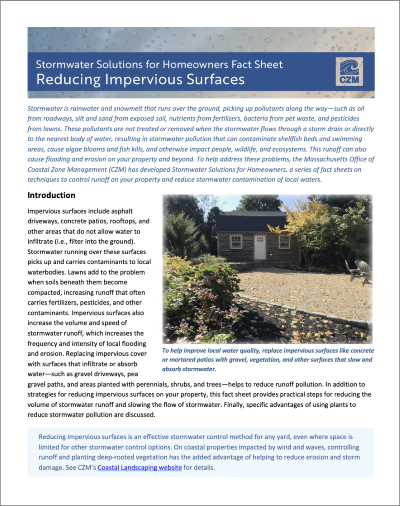The Stormwater Solutions for Homeowners fact sheets—developed by CZM as part of the Coastal Water Quality Program—give property owners a variety of options to effectively reduce runoff pollution and other stormwater impacts to local waters.
Fact Sheet Summary
This fact sheet focuses on reducing impervious (i.e., surfaces that prevent water from filtering into the ground). Stormwater that runs over impervious surfaces can pick up and carry contaminants to local waterbodies, and these surfaces also cause more stormwater to flow offsite quickly, leading to local flooding and erosion. Runoff pollution can be significantly reduced by replacing impervious surfaces with gravel driveways, pea gravel paths, planted areas, and other options that infiltrate or absorb water, reducing runoff volumes and slowing runoff flow.
For the complete PDF version of the fact sheet, download Stormwater Solutions for Homeowners Fact Sheet: Reducing Impervious Surfaces (4 MB).
Other Available Stormwater Solutions Fact Sheets
Fact sheets are currently available on these techniques:
- Vegetated Buffers - Trees, shrubs, high grasses, perennials, and other vegetation can be strategically planted to help slow, capture, and filter runoff and reduce stormwater impacts.
- “Green” Lawn and Garden Practices - Environmentally friendly yard care methods—such as planting native species, conserving water, and reducing fertilizer and chemical use—help to protect water quality and can save time and money.
- Rain Gardens - Rain gardens are specially designed and planted depressions in the ground that collect, filter, and treat stormwater.
- Vegetated Swales - Vegetated swales are channels with moisture-loving plants and amended soils that intercept, treat, and slowly convey stormwater runoff to where it can be effectively infiltrated.
- Minimizing Contaminants - Household contaminants—such as oil from automobiles, toxins from pesticides and cleaning products, and bacteria from pet waste and septic systems—can contribute to stormwater pollution. But simple changes at home, from reducing fertilizer use to properly disposing of batteries and other hazardous household products, can help keep inland and coastal waters clean.
- Preventing Erosion - Stormwater can carry sediments that fill storm drains, obstruct channels, smother wetlands, and cause other water quality and habitat impacts. Erosion and sediment controls can help slow and redirect stormwater, reducing erosion and capturing sediments and attached pollutants on site.
